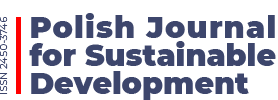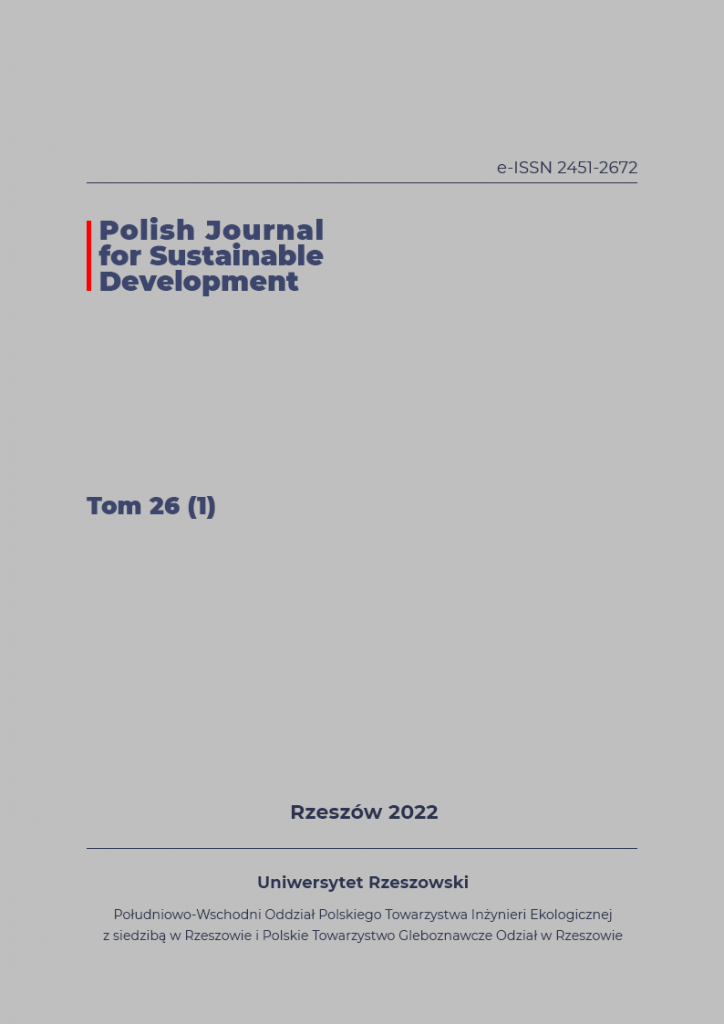Wypas koni huculskich jako forma zrównoważonego rolnictwa w rejonie Bieszczadów
DOI:
https://doi.org/10.15584/pjsd.2022.26.1.6Słowa kluczowe:
pastwiska górskie, wypas, zrównoważone rolnictwo, konie huculskieAbstrakt
Celem badań była ocena prowadzenia wypasu koni huculskich jako elementu zrównoważonego rolnictwa na terenach objętych ochroną w ramach NATURA 2000. Oceniono kondycję koni i obciążenie pastwisk oraz liczbę występujących i żerujących ptaków. Obciążenie do 10 DPJ, wynikające z realizacji programów rolno-środowiskowych, wydaje się być adekwatne zarówno jeśli chodzi o przeciwdziałanie sukcesji, jak i ochronę przed degradacją. Uzyskane wyniki potwierdzają pozytywny wpływ prowadzenia wypasu na różnorodność gatunkową siedlisk, przyczyniając się do zachowania miejsc gniazdowania i żerowania ptaków.
Downloads
Bibliografia
Bernatek A. 2012. Uwarunkowania rozczłonkowania stoków w Bieszczadach Wysokich. Roczniki Bieszczadzkie. 20. 230-246.
Biernacka M. 1989. Społeczność wiejska po II wojnie światowej w Bieszczadach. Etnografia Polska. T. 33. 2. 137-149.
Buckingham D.C., Peach W.J., Fox D.S. 2006. Effects of agricultural management on the use of lowland grassland by foraging birds. Agr. Ecosyst. Environ. 112. 21-40.
Carrol C.L., Huntington P.J. 1988. Body condition scoring and weight estimation of horses. Equine Vet. J. 20. 41-45.
Chabuz W., Grzywaczewski G., Rysiak A., Cios S., Podolak G., Litwińczuk Z. 2012. Wpływ wypasu lokalnych ras bydła na różnorodność biologiczną łąk i pastwisk Polesia Lubelskiego. Roczniki Nauk. PTZ. 8(4). 81-90.
Czerwiński M., Woodcock B.A., Golińska B., Kotowski W. 2018. The effect of tillage management and its interaction with site conditions and plant functional traits on plant species establishment during meadow restoration. Ecol. Eng. 117. 28-37.
Dowler L.E., Siciliano P.D., Pratt-Phillips S.E., Poore M. 2012. Determination of pasture dry matter intake rates in different seasons and their application in grazing management. J. Equine Vet. Sci. 32. 85-92. doi:10.1016/j.jevs.2011.06.006.
Eschen R., Brook A.J., Maczey N., Bradbury A., Mayo A., Watts P., Buckingham D., Wheeler K., Peach W. 2012. Effects of reduced grazing intensity on pasture vegetation and invertebrates. Agr. Ecosyst. Environ. 151. 53-60.
Fleurance G., Duncan P., Fritz H., Gordon I.J., Grenier-Loustalot M-F. 2010. Influence of sward structure on daily intake and foraging behaviour by horses. Anim. 4-3. 480-485.
Fleurance G., Fritz H., Duncan P., Gordon I.J., Edouard N., Vial, C. 2009. Instantaneous intake rate in horses of different body sizes: Influence of sward biomass and fibrousness. Appl. Anim. Behav. Sci. 117, 84-92. doi:10.1016/j.applanim.2008.11.006.
Gorczyca E., Izmaiłow B., Krzemień K., Wrońska-Wałach D. 2011. Stan badań geomorfologicznych w Bieszczadach. Roczniki Bieszczadzkie. 19. 29-317.
Greguła-Kania M., Dudko P., Kulik M., Warda M., Grzywaczewski G., Gruszecki T.M., Junkuszew A., Patkowski K., Tomczuk K. 2017. Wpływ wypasu na środowisko przyrodnicze. [w:] T.M. Gruszecki (red.). Przeżuwacze w czynnej ochronie środowiska. Standruk Lublin. 205-256.
Grzywaczewski G., Cios S., Zajdel M. 2012. Wykorzystanie ptaków jako wskaźników zmian siedliskowych łąk i pastwisk. [w:] T.M. Gruszecki (red.). Czynna ochrona wybranych siedlisk Natura 2000 z wykorzystaniem rodzimych ras owiec. WFOŚiGW, Lublin. 53-63.
Gulshan A.B., Dasti A.A. 2012. Studies and animal grazing preference and socio-economic impacts of animals on human population. J. Agr. Biol. Sci. 7(3). 206-214.
Hartel T., Hanspach J., Abson D.J., Mathe O., Moga C.I., Fischer J. 2014. Bird communities in traditional wood-pastures with changing management in Eastern Europe. Basic Appl. Ecol. 15(5). 385-395. doi:10.1016/j.baae.2014.06.007.
Herzog F., Lüscher G., Arndorfer M., Bogers M., Balázs K., Bunce R.G.H., Dennis P., Falusi E., Friedel J.K., Geijzendorffer I.R., Gomiero T., Jeanneret P., Moreno G., Oschatz M.L., Paoletti M.G., Sarthou J.P., Stoyanova S., Szerencsits E., Wolfrum S., Fjellstad W., Bailey D. 2017. European farm scale habitat descriptors for the evaluation of biodiversity. Ecol. Indic. 77. 205-217. doi:10.1016/j.ecolind.2017.01.010.
Jerrentrup J.S., Seither M., Peterson U., Isselstein J. 2015. Little grazer species effect on the vegetation in rotational grazing system. Agr. Ecosyst. Environ. 202. 243-250.
Komac B., Pladevall C., Domenech M., Fanlo R. 2015. Functional diversity and grazing intensity in sub-alpine and alpine grassland in Andorra. Appl. Veg. Sci. 18. 75-85.
Miraglia N., Costantini M., Polidori M., Meineri G., Peiretti G. 2008. Exploitation of a natural pasture by wild horses: comparison between nutritive characteristics of the land and the nutrient requirements of the herds over a 2-year period. Anim. 2-3. 410-418.
Pardini A., Nori M. 2011. Agro-silvo-pastoral systems in Italy: integration and diversification. Pastoralism: Research, Policy and Practice 1. 26. doi:10.1186-2041-7136-1-26.
Sidoropoulou A., Karatassion M., Galidaki G., Saklavou P. 2015. Landscape pattern changes in response to transhumance abandonment on Mountain Vermio (North Greece). Sustainability. 7. 15652-15673.
Steward G.B., Pullin A.S. 2008. The relative importance of grazing stock type and grazing intensity for conservation of mesotrophic “old meadow” pasture. J. Nat. Conserv. 16. 175-185. doi:10.1016/j.jnc.2008.09.005.
Szymanowska A., Gruszecki T.M., Drozd L., Szczepaniak K., Tajchman K., Tomczuk K., Greguła-Kania M. 2017. Wypas jako forma ochrony środowiska przyrodniczego. [w:] T.M. Gruszecki (red.). Przeżuwacze w czynnej ochronie środowiska. Standruk Lublin. 179-204.
Tichit M., Renault O., Potter T. 2005. Grazing regime as a tool to assess positive side effects of livestock farming systems on wading birds. Livest. Prod. Sci. 96. 109-117.
Tryjanowski P., Kuźmik S., Kujawa K., Jerzak L. 2009. Ekologia ptaków krajobrazu rolniczego. Bogucki Wyd. Nauk. Poznań.
Wilk T., Bobrek R., Pępkowska-Król A., Neubauer G., Kosicki J.Z. 2016. Ptaki polskich Karpat – stan, zagrożenia, ochrona. OTOP Marki.
Wolski J. 2007. Przekształcenia krajobrazu wiejskiego Bieszczadów Wysokich w ciągu ostatnich 150 lat. Prace Geograficzne IGiPZ PAN. 214.
Wolski J. 2009. Trwałość krajobrazu wiejskiego na przykładzie przekształceń zbiorowisk roślinnych bieszczadzkiej „krainy dolin” w ciągu ostatnich 150 lat. Chrońmy Przyrodę Ojczystą, 65(6). 441-448.
Zalba S.M., Cozzani N.C. 2004. The impact of feral horses on grassland bird communities in Argentina. Anim. Conserv. 7. 35-44.
Żmihorski M., Kotowska D., Berg A., Part T. 2016. Evaluating conservation tools in Poland grassland: The occurrence of birds in relations to agri-environment schemes and Natura 2000 areas. Biol. Conserv. 194. 150-157. doi:10.1016/j.biocon.2015.12.007.
Pobrania
Opublikowane
Numer
Dział
Licencja
Prawa autorskie (c) 2022 Polish Journal for Sustainable Development

Utwór dostępny jest na licencji Creative Commons Uznanie autorstwa – Użycie niekomercyjne – Bez utworów zależnych 4.0 Międzynarodowe.


